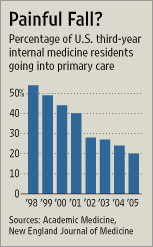American Physicians Make a Lot of Money!
They average more than any other occupation and considerably more than their European counterparts.

WaPo’s Andrew Van Dam (“The average doctor in the U.S. makes $350,000 a year. Why?“):
The average U.S. physician earns $350,000 a year. Top doctors pull in 10 timesthat.
When those simple data points were first presented in 2020, a small subset of physicians came unglued on the microblogging site formerly known as Twitter, slinging personal insults and at least one deeply unflattering photo illustration of an economist.
We couldn’t understand why. The figures are nigh-on unimpeachable. They come from a working paper, newly updated, that analyzes more than 10 million tax records from 965,000 physicians over 13 years. The talented economist-authors also went to extreme lengths to protect filers’ privacy, as is standard for this type of research.
By accounting for all streams of income, they revealed that doctors make more than anyone thought — and more than any other occupation we’ve measured. In the prime earning years of 40 to 55, the average physician made $405,000in 2017 — almost all of it (94 percent) from wages. Doctors in the top 10 percent averaged $1.3 million. And those in the top 1 percent averaged an astounding $4 million, though most of that (85 percent) came from business income or capital gains.
I would likely have guessed a lower figure, based on the notion that a large share of physicians* are in family practice and other generalist fields that are less lucrative. Still, it’s not surprising that they earn a lot of money; indeed, I’ve always assumed that to be conventional wisdom.
In certain specialties, doctors see substantially more in their peak earning years: Neurosurgeons (about $920,000), orthopedic surgeons ($789,000) and radiation oncologists ($709,000) all did especially well for themselves. Specialty incomes cover 2005 to 2017 and are expressed in 2017 dollars.
That’s a lot of money! But, again, I’m not shocked. These are highly specialized and competitive fields requiring years and years of training.
Not all doctors breathe that rarefied air. Even in these peak years, family-practice physicians made around $230,000 a year. General practice ($225,000) and preventive-medicine ($224,000) doctors earned even less — though that’s still enough to put them at the top of the heap among all U.S. earners.
That’s both considerably more than I make and more than I’d have guessed. Generalists have done an effective job of selling us on the idea that they don’t make a lot of money.
So why did those figures ruffle so many physician feathers?
“A lot of students go into medicine because they want to help patients,” Stanford economist Maria Polyakova told us. Polyakova and economist Joshua Gottlieb of the University of Chicago spent the past five years working on this data in collaboration with Census Bureau economists Kevin Rinz and Victoria Udalova and the University of New Brunswick’s Hugh Shiplett.
She continued: “There is this sense of, well, if you show that physician incomes put them at the top of the income distribution, then you’re somehow implying that they’re instead going into medicine because they want to make money.And that narrative is uncomfortable to people.”
Added Gottlieb: “You can want to help people and you can simultaneously want to earn money and have a nicer lifestyle and demand compensation for long hours and long training. That’s totally normal behavior in the labor market.”
Both things can be true. Presumably, most people who go into the medical professions generally care about helping people. But one suspects that getting into medical school would be decidedly less competitive were the rewards considerably less.**
Yale University economist Jason Abaluck notes that when he asks the doctors and future doctors in his health economics classes why they earn so much, answers revolve around the brutal training required to enter the profession. “Until they finish their residency, they’re working an enormous number of hours and their lifestyle is not the lifestyle of a rich person,” Abaluck told us.
That is true. Our analysis of Census Bureau data shows that residents are in an exclusive class with oil field roughnecks when it comes to hours worked in their late 20s and early 30s; firefighting managers such as captains and lieutenants also come close. And those blue-collar jobs pay about as well as medical residencies— often a bit better. At least until the residents become physicians and settle into working fewer hours and earning, um, more.
Residency also extends your educationinto your late 20s and beyond, cutting into your lifetime earning potential. And, as Abaluck’s students often point out, that long medical education also leads to astonishingly high student debt — an average of $246,000 as of 2017. But that debt almost vanishes against a physician’s still more-than-robust expected $10 million in lifetime income.
I have less sympathy for the delayed gratification argument than most since most PhD programs require similar amounts of post-graduate schooling without the near-guaranteed employment in the field than those who graduate medical school can look forward to. Still, there’s no denying that med school and residency is grueling.
But, of course, we don’t reward people for inputs. Indeed, PhD graduates from even very good schools have a difficult time finding full-time employment in the field*** and often wind up either as contingent faculty or under-employed outside academia.
So, why do physicians make that much?
One unfair, inflammatory and accurate answer would be that they like money.
On average, doctors — much like anyone else — behave in ways that just happen to drive up their income. For example, the economists found that graduates from the top medical schools, who can presumably write their own ticket to any field they want, tend to choose those that pay the most.
“Our analysis shows that certainly physicians respond to earnings when choosing specialties,” Polyakova told us. “And there’s nothing wrong with that, in my opinion.”
They also found that each 10 percent increase in the Medicare payment rate for a procedure causes a 4.4 percent increase in billing for the procedure — mostly because the doctor will work to find additional patients who could benefit from the now-more-profitable intervention.
“We can’t just sit back and say, ‘Oh doctors, they’re good people. They wouldn’t possibly do this,’” Gottlieb said. “They may be very good people, but that doesn’t mean that they don’t care about economics.”
But that’s simply stupid analysis. Who among us doesn’t like money? I would be quite pleased if everyone reading this would send me $1000. Alas, they won’t.
And American physicians seem to be quite talented at caring about economics.
“In general, U.S. physicians are making about 50 percent more than German physicians and about more than twice as much as U.K. physicians,” internal medicine physician Atul Grover told us. Grover leads the Association of American Medical Colleges’ Research and Action Institute, teaches medicine at George Washington University and speaks with the easy authority and charisma of someone who probably deserves to be earning several times what we do.
Grover said the widest gaps were “really driven by surgeons and a handful of procedural specialties,” doctors who perform procedures with clear outcomes, rather than preventing disease or treating chronic conditions. In the United States, “we’re not about prevention, you know?” he said, noting that his own PhD is in public health. “I wish it was different, but it ain’t!”
Okay, but that’s just whining about the realities of the current market, not a helpful diagnosis of the problem.
Finally, we start getting to the answer to the titular question:
Doctors do tend to be at the top of the earnings scale in every country, research shows. But their especially high incomes in the United States are undoubtedly related to America’s doctor shortage.
The United States has fewer doctors per person than 27 out of 31 member countries tracked by the Organization for Economic Cooperation and Development, a club of mostly economically advanced nations that supplies a surfeit of stats you can’t find almost anywhere else.
In 1970, based on a slightly different measure that’s been tracked for longer, America had more licensed physicians per person than all but two of the 10 countries for which we have data. What caused the collapse?
Casting about for an answer, we recalled a fascinating submission from reader Sonia Bisaccia in West Chester, Pa. She noted that the United States has far fewer residency slots than qualified med school graduates, which means thousands of qualified future physicians are annually shut out of the residency pipeline, denied their chosen career and stuck with no way to pay back those quarter-million-dollar loans.
“I’d like to see an in-depth analysis of the effect of the government capping the number of residency spots and how it’s created an artificial ‘physician shortage’ even though we have thousands of talented and graduated doctors that can’t practice due to not enough residency spots,” Bisaccia wrote.
This is adjacent to the answer that I would have predicted. My longstanding understanding was that the problem was that the AMA had created a cartel by artificially keeping highly qualified applicants out of medical school. It appears that we’ve actually created an artificial bottleneck at the residency level—which is even worse, compounding inefficiency with injustice.
Although, oddly, the next paragraphs comport with my previous understanding:
What a tremendous suggestion! Such an analysis would begin with a deeply influential 1980 report, according to Robert Orr, who has untangled this history over at the Niskanen Center, a center-right but far-from-orthodox D.C. think tank. (Orr recently became a health-care-focused aide for freshman Republican Sen. J.D. Vance of Ohio.)
That report, by a federal advisory committee tasked with ensuring the nation had neither too few nor too many doctors, concluded that America was barreling toward a massive physician surplus. It came out just before President Ronald Reagan took office, and the new administration seemed only too eager to cut back on federal spending on doctor-training systems.
In response to the report and the end of some federal grant programs, the mighty Association of American Medical Colleges (AAMC), a coalition of MD-granting medical schools and affiliated teaching hospitals, slammed the brakes on a long expansion. From 1980 to around 2004, the number of medical grads flatlined, even as the American population rose 29 percent.
Federal support for residencies was also ratcheted down, making it expensive or impossible for hospitals to provide enough slots for all the medical school graduates hitting the market each year. That effort peaked with the 1997 Balanced Budget Act which, among other things, froze funding for residencies — partially under the flawed assumption that HMOs would forever reduce the need for medical care in America, Orr writes. That freeze has yet to fully unwind.
It’s weird to directly blame the Reagan administration for the problem while eliding that the second change happened under the Clinton administration. Regardless, the fact remains that we’re producing far fewer physicians than we have highly talented and eager applicants.
I find this almost comical:
The idea that there could be too many doctors might sound ridiculous — especially these days, when a global pandemic, burnout and changing markets have reshaped the medical profession. In 2021, a large survey found that about 1 in 5 doctors intended to leave their current practice within two years, and the share of physicians in private practice fell from 56 percent in 2016 to 47 percent in 2022, according to the American Medical Association.
But for decades, many policymakers believed more doctors caused higher medical spending. Orr says that’s partly true, but “the early studies failed to differentiate between increased availability of valuable medical services and unnecessary treatment and services.”
“In reality, the greater utilization in places with more doctors represented greater availability, both in terms of expanded access to primary care and an ever-growing array of new and more advanced medical services,” he writes. “The impact of physician supply on levels of excessive treatment appears to be either small or nonexistent.”
It’s a truism in economics that more competition drives down prices. It therefore seems obvious that having more physicians competing for patients is a good thing.
If health costs keep you up at night, research suggests there are better ways to rein them in than what Orr would call rationing the supply of doctors. Polyakova and her collaborators find doctor pay consumes only 8.6 percent of overall health spending. It grew a bit faster than inflation over the time period studied, but much slower than overall health-care costs.
“People have a narrative that physician earnings is one of the main drivers of high health-care costs in the U.S.,” Polyakova told us. “It is kind of hard to support this narrative if ultimately physicians earn less than 10 percent of national health-care expenditures.”
Regardless, the dramatic limits on medical school enrollment and residencies enjoyed strong support from the AAMC and the AMA. We were surprised to hear both organizations now sound the alarm about a doctor shortage. MD-granting medical schools started expanding again in 2005.
Someone like Orr might say it’s because states have responded to the shortage by empowering nurse practitioners and physician assistants to perform tasks that once were the sole province of physicians. Over the past 20 years, the number of registered nurses grew almost twice as quickly as the number of doctors, and the number of physician assistants grew almost three times as rapidly, our analysis showed.
Osteopathic schools, which grant DO degrees, were also fast to respond to the physician shortage, doubling in number since the turn of the millennium, according to the American Association of Colleges of Osteopathic Medicine. DO is a legally equivalent medical degree that features additional training in hands-on, chiropractic-like treatment, and those who earn it are more likely to go into primary care.
While there still aren’t enough residency positions, we’re getting more thanks in part to recent federal spending bills that will fund 1,200 more slots over the next few years.
Honestly, while the focus on the provider shortage is understandable, I’d argue that it’s our entire healthcare model that’s at issue. German and British physicians make less than ours because their government foots more (in the UK case, essentially all) of the bill and therefore controls prices.
Our fee-for-service model, which is compounded by private insurance paying for said services, creates some weird incentives. We’ve seen this in the field of dentistry, for example, where there has been a cottage industry in performing unnecessary and even dangerous procedures to generate revenue.
________________
*While I realize it’s a losing battle, I prefer to use “physician,” “dentist,” “optometrist,” and other specific descriptors for medical professionals who have doctoral-level degrees given that “doctor” came from the Latin for “to teach” and referred to scholars for centuries before it got appropriated.
**That’s true of other professions as well, of course. I often remind my students who talk about “selfless service” and the sacrifices of military officers that I suspect fewer of them would make a career of it if the pay were that of a janitor.
***There’s wide variation depending on discipline, to be sure, but tenure-track jobs in academia have been hard to find for decades now.






I’d like to see the median income numbers and distributions. There’s been a lot of discussion about getting enough doctors in rural and underserved areas.
There is no great mystery why physicians make a lot of money; it’s simple economics. Medicine is highly regulated. Every aspect of medicine is covered under a zillion laws and rules. You cannot start your own medical school and teach people to be doctors without regulations. You can’t call yourself a doctor without a state license. Hospitals have to be approved by the state. Etc, etc. This environment creates a monopoly divorced from the free market. Guess who writes the rules. Physicians make a lot of money by collecting monopoly rents.
A lot of physicians claim that they are free market conservatives but don’t acknowledge that they are rich because they are outside the discipline that a free market brings to prices. Free markets for you; monopoly for me! It’s great, no mystery.
Physicians making a lot of money is not a problem in itself, but is an issue because:
1) It’s one of the factors that drive up already very high healthcare costs.
2) Despite the much higher costs, health outcomes generally aren’t better than in lower-cost healthcare markets.
So it’s not strange that physician incomes face some scrutiny – although I would be quite surprised if this is the biggest factor needlessly driving up costs.
“By accounting for all streams of income, they revealed that doctors make more than anyone thought — and more than any other occupation we’ve measured.”
Well… what occupations did they measure? This strains credibility and doesn’t stand up to even some facile Googling.
CEOs outpace them significantly.
“16. What’s the average salary for a CEO?
CEOs bring in a pretty penny, averaging $11.7 million in pay for 2013. That number has reached $20 million in 2021. That makes the $35,000 the average worker earns each year look like chump change.” (Source: https://www.creditdonkey.com/ceo-statistics.html)
That is based on a approximately 200-250K CEOs, based on the year. Well, maybe that doesn’t encompass all of them? Okay… for them to fall below doctors, there would need to be millions of CEOs working for free.
Sorry, I know that isn’t the crux of the article but it seems weird to incorporate that when it is just so obviously not true.
I’m not shocked or upset doctors make a lot of money.
@Kazzy: “CEO” isn’t an occupation; it’s a job title.
I recall seeing a demographic report maybe 15 or 20 years ago that predicted we would start to see shortages in most worker categories in the early 2020’s. Covid probably delayed that a bit, but it’s here now, and no small part of it is simple demographics. Somebody that got into med school and residency before the restrictions of the 80’s described above, would probably be retiring now.
So, yeah, we probably need to roll back those restrictions. It’s probably not going to be in time, but it’s better than nothing.
This could be broadened to the entire US health care system.
Everyone knows this, but it bears repeating…we pay more for worse results than anyone in the developed world.
And it is not going to change.
@Slugger:
J. K. Galbraith stated as a rule that organizations evolve to serve those who control them. And in medicine that’s becoming less the doctors than the venture capitalists who are buying up the practices to create local monopolies.
@gVOR10: No question, you have a good point. However, doctors have a duty to act in the patients’ best interest but are not speaking out about this issue unless there is a personal doctor/healthcare system conflict. The doctors’ mouths have been stuffed with money. The monopoly healthcare companies are smart enough to spread the money around. I don’t know if Adam Smith wrote about this, but I’m sure Don Corleone understood the principle.
I think everyone who follows this has known the gist for a long time. Unfortunately, the medical lobbies are very powerful and have stymied reform efforts that might impact compensation.
The driver seems to be the interaction between regulatory capture by the physicians’ guild and the misguided attempt to treat healthcare costs as discretionary spending by individuals rather than as societal costs of a public good. Regulatory capture holds down supply in two ways — first, by limiting the raw number of certified physicians, and second by creating unnecessary transaction costs to changing doctors or shopping around. The idiotic fee system, in which what you owe is a function of who your subsidy* is from (and thus generally of who you work for) makes it essentially impossible to treat even truly elective medicine as a market. And most medicine isn’t elective, or shouldn’t be.
*I object to calling it “insurance” — it isn’t, any more than paying for food is “starvation insurance”.
As a comparison, Germany. The insurers totally run the game there, and apparently have strong incentives to limit total medical costs.
How Doctors Get Paid
Nearly all hospital-based doctors are salaried, and those salaries are part of hospital budgets that are negotiated each year between hospitals and “sickness funds” — the 240 nonprofit insurance companies that cover nearly nine out of 10 Germans through their jobs. (About 10 percent, who are generally higher income, opt out of the main system to buy insurance from for-profit companies. A small fraction get tax-subsidized care.)
Office-based doctors in Germany operate much like U.S. physicians do. They’re private entrepreneurs who get a fee from insurers for every visit and every procedure they perform. The big difference is that groups of office-based physicians in every region negotiate with insurers to arrive at collective annual budgets.
Somehow in the US system insurers have no comparable incentive. I suspect the condition in the EU is a legacy of WW2, after which the nations were so economically and otherwise devastated the governments HAD to step heavily into the industry or it wouldn’t have existed at all. It created a strong culture of limiting profiteering. Nothing came along to change that so it still exists today. Docs still at the top of wage earners…but by a much, much, smaller margin.
Complicated topic that I have looked at for a long time ie health care policy and economics. I would start by saying that if we ever decide to reform health care and address costs physician pay needs to be on the table. Pay is probably too high for docs**, especially for those in the upper ranks. James is right that it takes a long time to train to be an ortho surgeon, but it’s about the same as others making much, much less. (Will comment from memory so names and exact numbers may be off a bit.)
On how we got here, it goes back to the GMENAC (govt financed but a private group as I recall) study about 1980. It projected a large oversupply of docs so new med schools didnt get built. This was a decision by a lot of people and not just the AMA. In fact, AFAICT, the AMA had zero control over this. The GMENAC study was criticized heavily in JAMA, probably the closest thing to an official AMA journal. This turned out to be wrong and we needed more. In the mid 2000s we started creating more docs. I believe we had a nadir of about 21.2 per the unit used in the article and we are now at 26.7. I would note that doc pay during this about 25% increase in doc numbers has increased as rapidly as it ever has increased.
So the evidence that increasing the number of docs will decease doc pay is not that strong, granted that with a large enough increase it almost certainly does. Note that Canada has about 5% more docs than we do and their docs make about 30%-50% less depending upon your source. What we have done is make heavy use of mid-levels (PAs, NPs) to do much of the work that extra docs would do and we pay them much less than we do docs. There is a lot of unmet demand so if we create a bunch more new docs they would first meet those needs but if we then increased to Greece levels we would have docs doing stuff here that we now have mid-levels do.
That could leave us with lower doc pay and if that is your goal then we should do it. However, it would lead to very large increases in overall health care spending. As noted, doc pay is 8.6% of health care spending. It is the spending that docs control, not their direct pay, that accounts for most of health care spending. Add lots more docs and you could end up with a lot more spending. (The article hints at Provider induced demand which they think does not exist, claiming there is just unmet demand. I think there is a lot of literature showing it is real AND there is unmet demand.)
Now add in that everyone else in our health care system makes more money that their counterparts in the rest of the world. Our admin people make tons more, drug reps way more, even nurses, PT, OT techs etc. What we really have is a systemic problem where we are unable or unwilling to address costs.
**When I get attacked no one will remember I said this. Also, but it sounded petty so I left it out earlier but the very large salaries do tip things. Just take away the non-doctor pay of the top 1% and average pay drops to about $310k. Do the same for the next 5% and you are well below $300k. Then how do you account for those very, very large salaries? The system has always over-rewarded proceduralists. Not sure why. Anyway, it’s complicated.
Steve
I suspectthat average physician pay is heading down. More and more doctors in the US are becoming salaried, and even the ones who remain in private practice are now almost always a part of a larger practice (at least in towns of any size). Those joint practices are getting rolled up into even larger practices and eventually an individual physician is such a small cog in that machine that they are effectively an employee. And once professional management takes over any enterprise they start looking at efficiencies, and nothing increases efficiency like replacing high cost cogs with lower cost ones.
@MarkedMan: I should add that I know for a fact that surgeons, at least, in these large systems are highly incentivized to steer their patients who need surgery into the most expensive path possible. Get that extra MRI, assume the patient has blanket approved all kinds of things you “recommend” but really just describe as done deals, tell them they “get” post operative crutches and canes and various other things and then charge 10 times the cost for them. And there are “big data” (now, “AI”) consulting firms that help these practices, surgi-centers and hospitals identify the most and least lucrative surgery/patient combinations. These consultants charge a boat load of money and the medical providers are not paying those fees for the hell of it.
Average pay is increasing. One of the things that has happened as you note is that fewer docs are self employed. Most now work for hospitals or VC entities. In some areas that has lowered doc salaries but hospitals know which areas will generate them the most profit so they are competing and bidding up the salary of those specialties. That makes those Neurosurgeon and Orthopedic surgeon salaries so large. They make a lot of money on the hospital fees for what they do, not only the surgery but also the studies like MRIs they order.
Steve
@steve:
I know this is personal for you and I don’t mean to be a dick, but we are still in the consolidation and growth phase where the goal of all the investors involved in these physicians networks is acquire!acquire!acquire! But eventually we will enter the 10%-improvement-in-profits-every-year phase and they will look to start cutting costs. At that point the doctors are employees and the ones who even think they are capable of heading out on their own will be the older ones, who make the most money and will be replaced by ones making less.
I’m curious though, as I could certainly be wrong. You’re a physician, do you see a way to move from a large practice to a single physician practice?
I’m very dubious of these figures. Most doctors I know make substantially less. But the basic problem remains: we have created a system where no one has an incentive to control costs.
Patients don’t because healthcare costs are deducted before they see a paycheck. Only the self-employed know how much they’re really paying for insurance.
Insurers don’t because they just pass on the costs to employees.
Employers don’t because they just pass on the costs to employees.
So far, government attempts to control costs have been ham-fisted as best and counterproductive at worst.
I don’t know what the solution is, although recent the Finklestein proposal would be a step in the right direction (basic healthcare from Medicaid, buy-in to better insurance, patients pay then are reimbursed). But we’re seeing what happens when you’ve managed to set up a system where no one knows and few care how much anything costs.
In 1974, there were 7,174 hospitals in the US. By 2023, 6,129.
I am very thick skinned and already noted docs are probably overpaid. That said this issue is pretty nuanced I think so it can sound like being defensive.
There are still independent docs but there are a lot of forces that make it harder. On the doc side new docs dont really want to be on call all of the time so they join groups. In theory you can join with other independents to share call coverage but that has logistical headaches so unless you can go to an area that already has one of these groups people dont try to start one. If docs form a group they generally want to have an exclusive contract with the hospital/network they work with.
On the employer side the VC entities like employing docs because they make money off of them. They generally have them sign fairly harsh contracts with long restrictive covenants and commitments to work for 5 years or longer with penalties for leaving early. Hospitals want to employ docs because they can then control them. They know costs, if there are problems they have one entity to deal with. They may want to cut pay but the good hospitals realize they have to pay market rates. For non-hospital based docs like family practice and pediatrics they want to control where they admit, do their tests and send referrals.
I have run a private practice group for a long time. About 200 providers. Private practice groups are now rare in my half of the state. Just a matter of time until the network decides to employ us.
Steve
@DrDaveT:
Don’t give the Rush Limbaughs of the world any ideas! They have enough bad thinking at their disposal already! :-X
@Hal_10000:
This is a total coincidence but our local paper financial columnist (Michael Taylor) just touted Finkelstein:
Taylor: Charting a path toward a sensible health care system. Basic universal coverage is key.
One place to start thinking about this is that the most portable physicians have pretty competitive salaries worldwide. Said another way when an international medical practitioner comes to the U. S. the easiest thing for them to do is internal medicine and that’s the most competitive.
Another thing to consider is that in 1965 the median physician income, median lawyer income, median engineer income, etc. were within about 10% of one another. Now the median physician salary in the U. S. is a multiple of the median engineer’s salary.
In terms of value in 1965 the physician then had much less to offer. Diagnostic tests were pretty primitive. The ICU had barely been invented and was not widespread. Remember that the world’s richest family had a premature baby die at 37 weeks, an age that now has close to 100% survival.
Steve